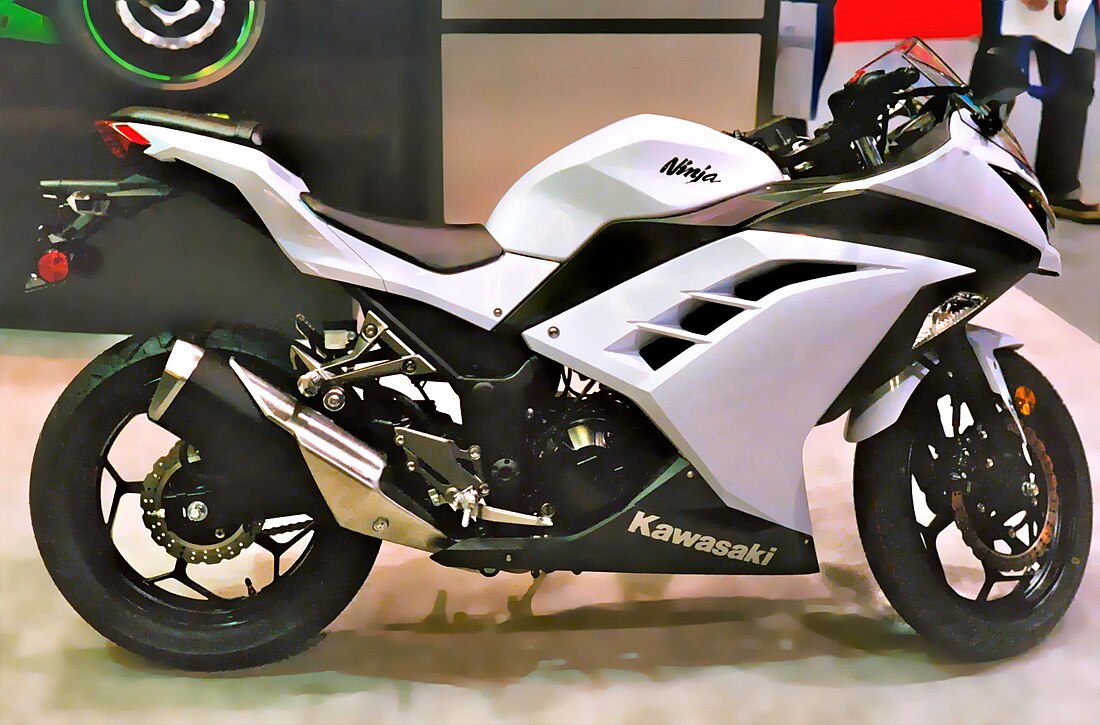Top Qs
Timeline
Chat
Perspective
Kawasaki Ninja 300
Type of motorcycle From Wikipedia, the free encyclopedia
Remove ads
The Kawasaki Ninja 300, or EX300, is a 296 cc (18.1 cu in) Ninja series sport bike introduced by Kawasaki in 2012 for the 2013 model year. It is sold in Asia, Australia, Europe, and North America.[5][6][7] When introduced, the Ninja 300R replaced the Ninja 250R in some markets, and in others they were sold alongside each other.[8][9] When the 2018 model year Ninja 400 was introduced, it replaced the 300 in some markets.[10]
Remove ads
Remove ads
Design
The Ninja 300 is based on the Ninja 250R, a lightweight and inexpensive sport bike in production for over three decades.[11] Like the Ninja 250R, it has a full fairing, but a wider rear tire, 140/70, instead of the 130/70 on the 250R.[12] The Ninja 300 also has 5 spoke wheels, neutral finder, and optional antilock braking system (ABS).[13][14] By comparison with the 250R, the Ninja 300 also has a slightly smaller fuel tank, taller gearing,[15] and a back-torque-limiting slipper clutch with an assist mechanism that decreases clutch lever effort.[4] Despite being a sport bike, it has comfortable ergonomics (such as windscreen effectively protecting from wind blast) which promotes commuting.[14]
Remove ads
Performance
The Ninja 300 has a 296 cc (18.1 cu in) straight-twin engine.[16] Dynamometer tests showed that the Ninja 300 produces more power with 39.95 hp (29.79 kW) compared with the 250's 25.48 hp (19.00 kW), and higher torque across the rev range at 18 to 13.57 lb⋅ft (24.40 to 18.40 N⋅m).[1][15]
Its top speed has been recorded at 180 km/h (112 mph) and acceleration at 5.6 seconds from 0 to 97 km/h (0 to 60 mph), and around 14.5 seconds at 141.14 to 145.77 km/h (87.7 to 90.58 mph) in the quarter mile.[1][2] The stopping distance from 97 to 0 km/h (60 to 0 mph) of the ABS model was 38.0 to 41.1 m (124.6 to 135 ft).[1][2]
The Ninja 300's fuel economy was measured at around 70 mpg‑US (3.4 L/100 km; 84 mpg‑imp), while other sources reported it at 54.1 mpg‑US (4.35 L/100 km; 65.0 mpg‑imp), though regardless of the methodology, the 300 showed improved gas mileage over the Ninja 250R.[1][2]
Remove ads
Rivals
The Ninja 300 competes with (and is commonly compared with) other entry-level (300/250 cc) bikes such as Yamaha R3, KTM RC390, Suzuki GSX250R and Honda CBR300R.[17]
Replacement
In an effort to increase its compliance with Euro IV, Kawasaki released the Ninja 400 which replaced the Ninja 300 in most markets.[18][19][20]
2022 Update
In 2022, the bike was released with new decals.[21] In August 2022, it is offered at an ex-showroom price of ₹3.4 lakh (US$4,000) in India.[22]
References
External links
Wikiwand - on
Seamless Wikipedia browsing. On steroids.
Remove ads





